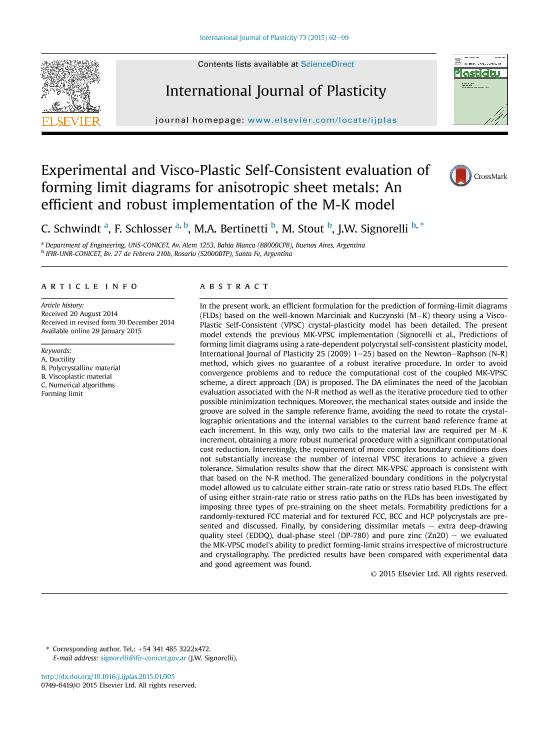Mostrar el registro sencillo del ítem
dc.contributor.author
Schwindt, Claudio Daniel

dc.contributor.author
Schlosser, Fernando
dc.contributor.author
Bertinetti, María de Los Angeles
dc.contributor.author
Stout, M.
dc.contributor.author
Signorelli, Javier Walter

dc.date.available
2016-06-09T20:46:37Z
dc.date.issued
2014-12
dc.identifier.citation
Schwindt, Claudio Daniel; Schlosser, Fernando; Bertinetti, María de Los Angeles; Stout, M.; Signorelli, Javier Walter; Experimental and Visco-Plastic Self-Consistent evaluation of forming limit diagrams for anisotropic sheet metals: An efficient and robust implementation of the M-K model; Elsevier; International Journal of Plasticity; 73; 12-2014; 62-99
dc.identifier.issn
0749-6419
dc.identifier.uri
http://hdl.handle.net/11336/6141
dc.description.abstract
In the present work, an efficient formulation for the prediction of forming-limit diagrams (FLDs) based on the well-known Marciniak and Kuczynski (MK) theory using a Visco- Plastic Self-Consistent (VPSC) crystal-plasticity model has been detailed. The present model extends the previous MK-VPSC implementation (Signorelli et al., Predictions of forming limit diagrams using a rate-dependent polycrystal self-consistent plasticity model, International Journal of Plasticity 25 (2009) 1e25) based on the NewtoneRaphson (N-R) method, which gives no guarantee of a robust iterative procedure. In order to avoid convergence problems and to reduce the computational cost of the coupled MK-VPSC scheme, a direct approach (DA) is proposed. The DA eliminates the need of the Jacobian evaluation associated with the N-R method as well as the iterative procedure tied to other possible minimization techniques. Moreover, the mechanical states outside and inside the groove are solved in the sample reference frame, avoiding the need to rotate the crystallographic orientations and the internal variables to the current band reference frame at each increment. In this way, only two calls to the material law are required per MK increment, obtaining a more robust numerical procedure with a significant computational cost reduction. Interestingly, the requirement of more complex boundary conditions does not substantially increase the number of internal VPSC iterations to achieve a given tolerance. Simulation results show that the direct MK-VPSC approach is consistent with that based on the N-R method. The generalized boundary conditions in the polycrystal model allowed us to calculate either strain-rate ratio or stress ratio based FLDs. The effect of using either strain-rate ratio or stress ratio paths on the FLDs has been investigated by imposing three types of pre-straining on the sheet metals. Formability predictions for a randomly-textured FCC material and for textured FCC, BCC and HCP polycrystals are presented and discussed. Finally, by considering dissimilar metals e extra deep-drawing quality steel (EDDQ), dual-phase steel (DP-780) and pure zinc (Zn20) e we evaluated the MK-VPSC model´s ability to predict forming-limit strains irrespective of microstructure and crystallography. The predicted results have been compared with experimental data and good agreement was found.
dc.format
application/pdf
dc.language.iso
eng
dc.publisher
Elsevier

dc.rights
info:eu-repo/semantics/openAccess
dc.rights.uri
https://creativecommons.org/licenses/by-nc-nd/2.5/ar/
dc.subject
Forming Limit
dc.subject
Anisotropy
dc.subject
Texture
dc.subject
Mk-Vpsc
dc.subject.classification
Ingeniería de los Materiales

dc.subject.classification
Ingeniería de los Materiales

dc.subject.classification
INGENIERÍAS Y TECNOLOGÍAS

dc.title
Experimental and Visco-Plastic Self-Consistent evaluation of forming limit diagrams for anisotropic sheet metals: An efficient and robust implementation of the M-K model
dc.type
info:eu-repo/semantics/article
dc.type
info:ar-repo/semantics/artículo
dc.type
info:eu-repo/semantics/publishedVersion
dc.date.updated
2016-06-01T13:49:06Z
dc.journal.volume
73
dc.journal.pagination
62-99
dc.journal.pais
Países Bajos

dc.journal.ciudad
Amsterdam
dc.description.fil
Fil: Schwindt, Claudio Daniel. Universidad Nacional del Sur. Departamento de Ingeniería; Argentina. Consejo Nacional de Investigaciones Científicas y Técnicas; Argentina
dc.description.fil
Fil: Schlosser, Fernando. Universidad Nacional del Sur. Departamento de Ingeniería; Argentina. Consejo Nacional de Investigaciones Científicas y Técnicas. Centro Científico Tecnológico Rosario. Instituto de Física de Rosario (i); Argentina
dc.description.fil
Fil: Bertinetti, María de Los Angeles. Consejo Nacional de Investigaciones Científicas y Técnicas. Centro Científico Tecnológico Rosario. Instituto de Física de Rosario (i); Argentina
dc.description.fil
Fil: Stout, M.. Consejo Nacional de Investigaciones Científicas y Técnicas. Centro Científico Tecnológico Rosario. Instituto de Física de Rosario (i); Argentina
dc.description.fil
Fil: Signorelli, Javier Walter. Consejo Nacional de Investigaciones Científicas y Técnicas. Centro Científico Tecnológico Rosario. Instituto de Física de Rosario (i); Argentina
dc.journal.title
International Journal of Plasticity

dc.relation.alternativeid
info:eu-repo/semantics/altIdentifier/url/http://www.sciencedirect.com/science/article/pii/S0749641915000145
dc.relation.alternativeid
info:eu-repo/semantics/altIdentifier/doi/10.1016/j.ijplas.2015.01.005
dc.relation.alternativeid
info:eu-repo/semantics/altIdentifier/doi/http://dx.doi.org/10.1016/j.ijplas.2015.01.005
Archivos asociados
